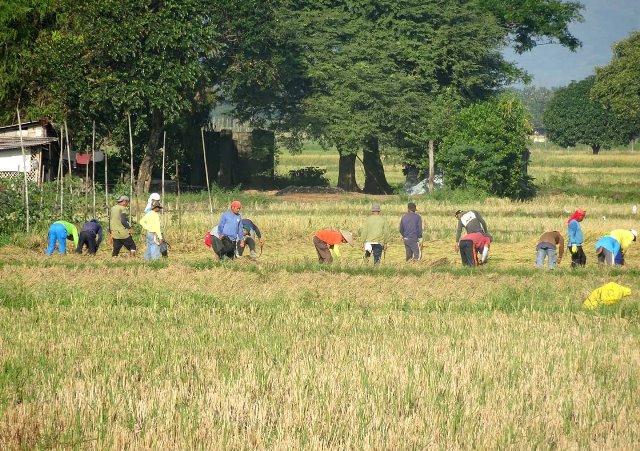Media on the Rice Tariffication Law: All Positive According to Their Sources

WITH THE signing of the Rice Tariffication Law, the Philippines in the coming months can expect a steady supply of rice; so claim its proponents, principally Senator Cynthia Villar. The measure, signed by President Duterte on February 14, lifts import limits and imposes tariffs on imported rice. It seeks to address the shortage in rice that can be sold at affordable prices.
Much of the media echoed the claim of its sponsors that the law will benefit Filipino consumers because it will bring down the price of rice and the rate of inflation. But the coverage left out problematic issues, particularly the impact the policy will have on Filipino farmers and the local rice industry. The reports failed to present this as a remarkable policy shift away from the objective of national rice sufficiency.
CMFR monitored reports by the broadsheets Manila Bulletin, the Philippine Daily Inquirer and The Philippine Star; primetime newscasts 24 Oras (GMA-7), Aksyon (TV5), News Night (CNN Philippines) and TV Patrol (ABS-CBN 2); as well as select news websites from February 15 to 24, 2019.
Routine Reporting
Most news accounts on the signing of the rice tariffication law merely reported what the law will supposedly do, particularly the promise of a more steady rice supply and lower market prices. Also noted was the assurance of safety nets for local farmers who will receive assistance under the law’s PHP10 billion Rice Competitiveness Enhancement Fund (RCEF). This would provide farmers with better farming tools, seeds and other means to improve their productivity.
Although coverage presented the concerns of farmers’ groups, these were limited to quotes, the exchange of which did not amount to a meaningful discussion of the plight of the farmers. Most news accounts were content with recording these reservations and juxtaposing them with the provisions of the law that address these concerns, such as the RCEF, without the necessary explanatory notes.
The reports failed to explain why agricultural groups are worried about the effect of the law as these did not go into the processes and production costs and the lack of basic support for farmers such as irrigation and market access, to more complex concerns for new knowledge about modern farming techniques and the mechanization of farm implements for improved productivity.
Coverage did not go into other problematic aspects of the issue, such as the Philippines’ vulnerability to the volatility of the cost and supply of imported rice, and its impact on the country’s food security. The media failed to bring these to light in its coverage by their reliance on quotes, which cannot satisfactorily present the central arguments about the law’s pro and cons.
The think-tank IBON Foundation has argued that the law will not be able to address these concerns. It published on February 19 a feature report that discussed three aspects that the law aims to address – improving farmers’ livelihood, lowering the price of rice and ensuring a stable rice supply. It cited the past failure of the Comprehensive Agrarian Reform Program (CARP). It discussed the impact of volatility of global prices and pointed out the fallacy of relying on imported rice to assure the country’s food security. This assessment was not used to expand the discourse.
Moving away from the reporting of the law’s projected benefits, Rappler’s report on February 13 looked into the industries that would be affected should the rice industry experience difficulties due to the implementation of the new law. The report identified those who will feel the pinch: millers, animal feed and beer producers, and biomass and construction industries, which rely on byproducts from the rice industry. The repercussions include possible hikes in pork and chicken prices due to diminished animal feed production; increased electricity costs in some areas where power providers rely on biomass which is fueled by rice hull; and millers defaulting on bank loans due to reduced operations.
Turning Away from Rice Self-sufficiency Policy
As the more liberal rice importation regime seeks to ensure that there will always be enough rice, the law suggests a policy shift away from rice self-sufficiency towards dependence on imported rice to achieve food security.
In July 2016, Agriculture Secretary Manny Piñol mentioned the need to achieve rice self-sufficiency by providing necessary assistance to farmers. In August 2017, he said that the Philippines may achieve its rice self-sufficiency goal by 2019. Piñol also continued to be optimistic about reaching the goal despite President Duterte’s pessimism. But in a February 23 report by the Inquirer’s Business section, Piñol was quoted as saying that the country must be “content” with a 93 percent rice sufficiency target, and that encouraging farmers to aim for 100 percent rice self-sufficiency was “foolish.” Unfortunately, the report merely quoted without examining Pinol’s statements.
The failure of rice sufficiency as a policy should have provided the context to the evaluation of the new law. If Piñol’s statements reflect a policy change, then media should find other sources from related departments, such as in the Budget, Finance and the Trade and Industry, and other relevant agencies such as the Philippine Institute for Development Studies, the Philippine Statistics Authority, and the Philippine Rice Research Institute to clarify whether the Piñol’s statements were backed by government data and action.
The media did not try to examine the news as policy; and thus left the pros and cons of rice tariffication in a gray area, lacking clarification or understanding.
Leave a Reply